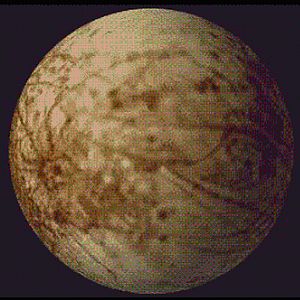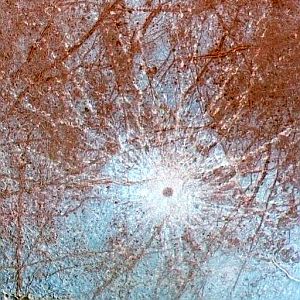
Für eine deutsche Übersetzung dieser Seite einfach die Brandenburger Flagge anklicken
 |
Click the Brandenburg Flag for a German translation Für eine deutsche Übersetzung dieser Seite einfach die Brandenburger Flagge anklicken |


|
|
EuropaA collection of pictures of Jupiter's moon Europa,
|
|



|
Europa is the second innermost of Jupiter's four
Galilean moons. Europa features a cracked, icy surface, suggesting a body of liquid water underneath, kept liquid by tidal heating. Europa was the first body discovered in the solar system other than Earth presumed to have an ocean and thus a potential for extraterrestrial life. Here are our favorite pictures of Europa. Like our other space galleries, the pictures have not been selected because of their scientific significance but because of their esthetic value and sometimes because of their historical importance. The picture to the left was taken by the Galileo space probe on September 7, 1996, at a range of 677,000 kilometers (417,900 miles). / Source: NASA/JPL/DLR / Wikipedia |


|
Europa was discovered on January 8, 1610 by Galileo Galilei. The Galilean moons were the first
discoveries of moons in the solar system other than Earth's moon. They also were the first objects discovered using a telescope. For the next 350 years, due to the limited resolution of telescopes, Europa and the other Galilean moons remained nothing more than light spec in a telescope. The first somewhat closeup picture of Europa was taken by Pioneer 10 on December 3, 1973. The image was taken from a distance of 324,000 km (201,000 mi), which was to far to reveal any details. However, the picture sparked the first speculations about Europa's icy surface. The first real closeup pictures, revealing Europa's surface features were taken by the Voyager space probes. |
  First image of Europa Source: NASA / Wikipedia |

  Artist's concept of Voyager 1 passing Europa Source: Naeblys / Alamy Stock Photo |
  Europa peeks from behind Jupiter Voyager 2, July 3, 1979 Source: NASA / Planetary Society |
  Europa over Jupiter's Great Red Spot Voyager 1, March 3 1979 Source: NASA / Planetary Society |

 |
 |
 |
|
Two stills of a gif showing Europa's rotation Source: Astronomy Picture of the Day |
Highest resolution image Voyager 2, July 9, 1979 Source: NASA / Planetary Society |

|
NASA's Galileo probe entered Jupiter's orbit on December 8, 1995 and remained in orbit
until September 21, 2003. In November 1997, the probe started its Galileo Europa mission, consisting of eight consecutive Europa flybys through February 1999. On Decemer 16, 1997, the probe performed its closet approach to Europa, passing at a distance of 196 km (122 mi.). |
  Artist's concept of Galileo passing Europa Source: Wikimedia & NASA / space.com |
  High resolution picture taken November 26, 2014 Source: NASA / JPL / ESA |

| The following images are mosaics, composed of a number of pictures from different flybys, which is why there are no dates given. All image were taken during the Galileo Europa mission between December 1997 and February 1999. See the sources for more details. |

  Reddish Bands on Europa Source: NASA / JPL |
  Pwyll Crater Source: NASA / JPL |
  Ruddy "Freckles" on Europa Source: NASA / JPL |

  Europa's Jupiter-facing hemisphere Source: NASA / Planetary Society |
  Conamara_Chaos Source: NASA / Planetary Society |
  Europa's trailing hemisphere Source: NASA / Planetary Society |


|
The Planetary Society and the
JPL Photo Journal host large collections of images taken
by Galileo. Aside from the Pioneer and Voyager probes and the two satellites Galileo and Juno, the only spacecraft that came somewhat close to Europa was New Horizons, which passed Jupiter on February 28, 2007 in a gravity assist maneuver. One day before closest approach to Jupiter, on February 27, 2007, New Horizon's LORRI camera, developed for very dim light, took a picture of Europa from a range of 3.1 million kilometers (1.9 million miles).
|
 Source: Source:NASA |


| Part of the Galileo Europa mission were a number of close flybys of the third of the Galilean moons, Callisto. |

|


|
|
Click here to return to Jupiter's moon Io | Click here to move on to Jupiter's moon Callisto |
|

|
Back to Solar System Page |
Back to Space Page |
Back to English Main Page |
 Back to Start Page |